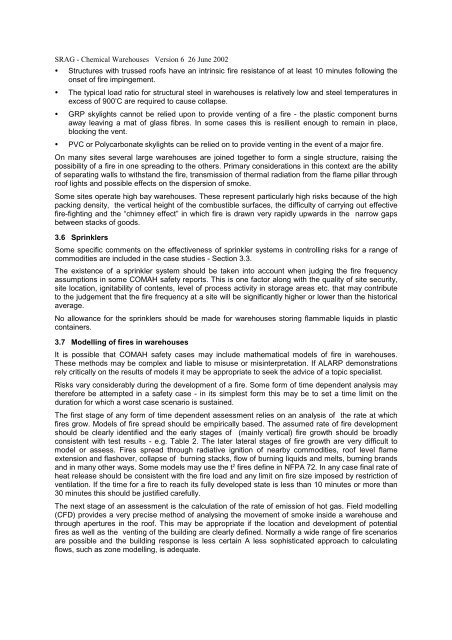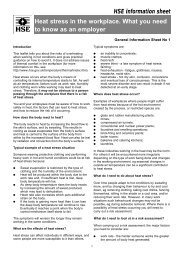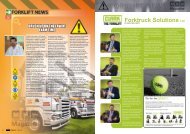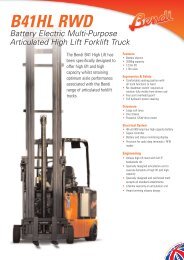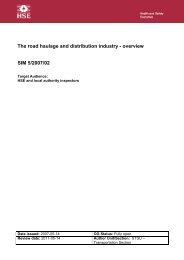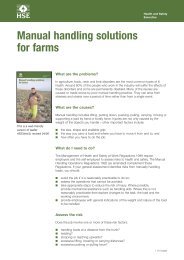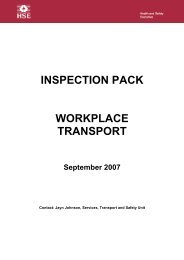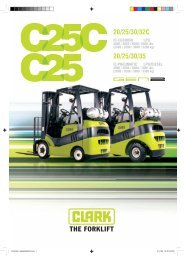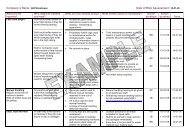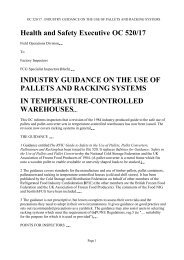Hazards - Forktruck Solutions Ltd.
Hazards - Forktruck Solutions Ltd.
Hazards - Forktruck Solutions Ltd.
Create successful ePaper yourself
Turn your PDF publications into a flip-book with our unique Google optimized e-Paper software.
SRAG - Chemical Warehouses Version 6 26 June 2002 Structures with trussed roofs have an intrinsic fire resistance of at least 10 minutes following theonset of fire impingement. The typical load ratio for structural steel in warehouses is relatively low and steel temperatures inexcess of 900’C are required to cause collapse. GRP skylights cannot be relied upon to provide venting of a fire - the plastic component burnsaway leaving a mat of glass fibres. In some cases this is resilient enough to remain in place,blocking the vent. PVC or Polycarbonate skylights can be relied on to provide venting in the event of a major fire.On many sites several large warehouses are joined together to form a single structure, raising thepossibility of a fire in one spreading to the others. Primary considerations in this context are the abilityof separating walls to withstand the fire, transmission of thermal radiation from the flame pillar throughroof lights and possible effects on the dispersion of smoke.Some sites operate high bay warehouses. These represent particularly high risks because of the highpacking density, the vertical height of the combustible surfaces, the difficulty of carrying out effectivefire-fighting and the “chimney effect” in which fire is drawn very rapidly upwards in the narrow gapsbetween stacks of goods.3.6 SprinklersSome specific comments on the effectiveness of sprinkler systems in controlling risks for a range ofcommodities are included in the case studies - Section 3.3.The existence of a sprinkler system should be taken into account when judging the fire frequencyassumptions in some COMAH safety reports. This is one factor along with the quality of site security,site location, ignitability of contents, level of process activity in storage areas etc. that may contributeto the judgement that the fire frequency at a site will be significantly higher or lower than the historicalaverage.No allowance for the sprinklers should be made for warehouses storing flammable liquids in plasticcontainers.3.7 Modelling of fires in warehousesIt is possible that COMAH safety cases may include mathematical models of fire in warehouses.These methods may be complex and liable to misuse or misinterpretation. If ALARP demonstrationsrely critically on the results of models it may be appropriate to seek the advice of a topic specialist.Risks vary considerably during the development of a fire. Some form of time dependent analysis maytherefore be attempted in a safety case - in its simplest form this may be to set a time limit on theduration for which a worst case scenario is sustained.The first stage of any form of time dependent assessment relies on an analysis of the rate at whichfires grow. Models of fire spread should be empirically based. The assumed rate of fire developmentshould be clearly identified and the early stages of (mainly vertical) fire growth should be broadlyconsistent with test results - e.g. Table 2. The later lateral stages of fire growth are very difficult tomodel or assess. Fires spread through radiative ignition of nearby commodities, roof level flameextension and flashover, collapse of burning stacks, flow of burning liquids and melts, burning brandsand in many other ways. Some models may use the t 2 fires define in NFPA 72. In any case final rate ofheat release should be consistent with the fire load and any limit on fire size imposed by restriction ofventilation. If the time for a fire to reach its fully developed state is less than 10 minutes or more than30 minutes this should be justified carefully.The next stage of an assessment is the calculation of the rate of emission of hot gas. Field modelling(CFD) provides a very precise method of analysing the movement of smoke inside a warehouse andthrough apertures in the roof. This may be appropriate if the location and development of potentialfires as well as the venting of the building are clearly defined. Normally a wide range of fire scenariosare possible and the building response is less certain A less sophisticated approach to calculatingflows, such as zone modelling, is adequate.


